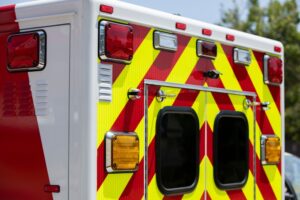It sounds like the plot of a summer horror movie. The creature that crawls in swimmers’ noses and eats their brains. But it’s not fiction.
So far three people have died this summer after contracting a rare – but almost always lethal – infection with a fresh water amoeba, Naegleria fowleri, which destroys the brain.
The amoeba flourishes in warm, fresh water. Consequently cases tend to occur in the southeastern US during the late summer. This summer’s fatalities occurred in Louisiana, Florida and, most recently, Virginia.
Here’s some information from the U.S. Centers for Disease Control (CDC) about this organism and amebic meningoencephalitis:
What is Naegleria?
Naegleria is an ameba (single-celled living organism) commonly found in warm freshwater (for example, lakes, rivers, and hot springs) and soil. Only one species (type) of Naegleria infects people: Naegleria fowleri.
How does infection with Naegleria fowleri occur?
Naegleria fowleri infects people by entering the body through the nose. This typically occurs when people go swimming or diving in warm freshwater places, like lakes and rivers. The Naegleria fowleri ameba travels up the nose to the brain where it destroys the brain tissue.
You cannot be infected with Naegleria fowleri by drinking contaminated water. In very rare instances, Naegleria infections may also occur when contaminated water from other sources (such as inadequately chlorinated swimming pool water or heated tap water <47°C) enters the nose, for example when people submerge their heads or cleanse during religious practices, and, possibly, when people irrigate their sinuses (nose).
Where is Naegleria fowleri found?
Naegleria fowleri is found around the world. In the United States, the majority of infections have been caused by Naegleria fowleri from freshwater located in southern-tier states. The ameba can be found in:
- Bodies of warm freshwater, such as lakes and rivers
- Geothermal (naturally hot) water, such as hot springs
- Warm water discharge from industrial plants
- Geothermal (naturally hot) drinking water sources
- Soil
- Swimming pools that are poorly maintained, minimally-chlorinated, and/or un-chlorinated
- Water heaters with temperatures less than 47°C (3, 4)
Naegleria fowleri is not found in salt water, like the ocean.
Can I get a Naegleria fowleri infection from a disinfected swimming pool?
No. You cannot get a Naegleria fowleri infection from a properly cleaned, maintained, and disinfected swimming pool.
How common are Naegleria fowleri infections in the United States?
Naegleria fowleri infections are very rare. In the 10 years from 2001 to 2010, 32 infections were reported in the U.S. Of those cases, 30 people were infected by contaminated recreational water and two people were infected by water from a geothermal (naturally hot) drinking water supply.
When do Naegleria fowleri infections most commonly occur?
While infections with Naegleria fowleri are very rare, they occur mainly during the summer months of July, August, and September. Infections are more likely to occur in southern-tier states, but can also occur in other locations. Infections usually occur when it is hot for prolonged periods of time, which causes higher water temperatures and lower water levels. Infections can increase during heat wave years.
Can infection be spread from one person to another?
No. Naegleria fowleri infection cannot be spread from one person to another.
What are the symptoms of Naegleria fowleri infection?
Naegleria fowleri causes the disease primary amebic meningoencephalitis (PAM), a brain infection that leads to the destruction of brain tissue. In its early stages, symptoms of PAM may be similar to symptoms of bacterial meningitis.
Initial symptoms of PAM start 1 to 7 days after infection. The initial symptoms include headache, fever, nausea, vomiting, and stiff neck. Later symptoms include confusion, lack of attention to people and surroundings, loss of balance, seizures, and hallucinations. After the start of symptoms, the disease progresses rapidly and usually causes death within 1 to 12 days.
Naegleria fowleri as seen in brain tissue (photo: CDC)
Is there effective treatment for infection with Naegleria fowleri?
It is not clear. Several drugs are effective against Naegleria fowleri in the laboratory. However, their effectiveness is unclear since almost all infections have been fatal, even when people were treated.
What should I do if I have been swimming or playing in freshwater and now think I have symptoms associated with Naegleria fowleri?
Infection with Naegleria fowleri is very rare. The early symptoms of Naegleria fowleri infection are more likely to be caused by other more common illnesses, such as meningitis. People should seek medical care immediately whenever they develop a sudden onset of fever, headache, stiff neck, and vomiting, particularly if they have been in warm freshwater recently.
How common is Naegleria fowleri in the environment?
Naegleria fowleri is commonly found in lakes in southern-tier states during the summer. This means that recreational water users should be aware that there will always be a low level risk of infection when entering these waters. In very rare instances, Naegleria has been identified in water from other sources (such as inadequately chlorinated swimming pool water or heated tap water <47°C).
Is there a routine and rapid test for Naegleria fowleri in the water?
No. It can take weeks to identify the ameba, but new detection tests are under development. Previous water testing has shown that Naegleria fowleri is very common in freshwater venues. Therefore, recreational water users should assume that there is a low level of risk when entering all warm freshwater, particularly in southern-tier states.
How does the risk of Naegleria fowleri infection compare with other water-related risks?
The risk of Naegleria fowleri infection is very low. There have been 32 reported infections in the U.S. in the 10 years from 2001 to 2010, despite millions of recreational water exposures each year. By comparison, in the ten years from 1996 to 2005, there were over 36,000 drowning deaths in the U.S.
How will the public know if a lake or other water body has Naegleria?
Recreational water users should assume that there is always a low level of risk whenever they enter warm freshwater (for example, when swimming, diving, or waterskiing) in southern-tier states. Posting signs is unlikely to be an effective way to prevent infections. This is because the location and number of amebae in the water can vary over time. In addition, posted signs might create a misconception that bodies of water without signs are Naegleria fowleri-free.
How can I reduce the risk of infection with Naegleria fowleri?
Naegleria fowleri is found in many warm freshwater lakes and rivers in the United States, particularly in southern tier states. It is likely that a low risk of Naegleria fowleri infection will always exist with recreational use of warm freshwater lakes, rivers, and hot springs. The low number of infections makes it difficult to know why a few people have been infected compared to the millions of other people using the same or similar waters across the U.S. The only certain way to prevent a Naegleria fowleri infection is to refrain from water-related activities in or with warm, untreated, or poorly-treated water.
If you do plan to take part in water-related activities, some measures that might reduce risk include:
- Avoid water-related activities in warm freshwater during periods of high water temperature and low water levels.
- Hold the nose shut or use nose clips when taking part in water-related activities in bodies of warm freshwater.
Avoid digging in, or stirring up, the sediment while taking part in water-related activities in shallow, warm freshwater areas.
Health Alert Flyers: Florida Department of Health













Comments for this article are closed.